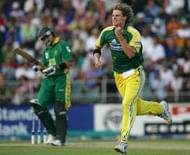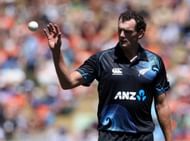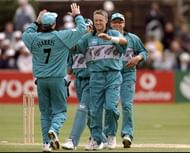3) Nathan Bracken, Australia (2001-2009)
Nathan Bracken was a great servant for his state New South Wales, and was successful in breaking into the national side during 2001 for the ODIs. He had tough competition with his fellow counterparts like Brad Williams, Andy Bickel, Ian Harvey, Shane Lee, Michael Kasporwicz, Mitchell Johnson, Stuart Clark, Shane Harwood, Jason Gillespie etc. Only Brett Lee had already cemented his place up with one of the most accurate bowling machines in the world called ‘Glenn Mcgrath’.
Nathan Bracken was an all-round bowler, where he was able to bowl at 140kmph and move the ball in both the direction with a new ball as well as could manipulate the deliveries by mapping the batsmen’s mind. When it comes to bowling at the death, he was perhaps the able successor to Ian Harvey. Most of the time, he delivered as he would have Gilly standing up to the stumps and would give no width to the batsman to free his arms. His also used reverse swing to a good effect by bowling some accurate yorkers.
In his International career which lasted for 8 years, Nathan Bracken took 174 wickets in 116 ODIs with an excellent economy of just 4.41 He was good in the T20 format too, but eventually lost his place as he was very injury prone.
4) Kyle Mills, New Zealand (2004-2015)
The tall New Zealander, who took the 2nd most wickets for his country after Daniel Vettori, was another version of Nathan Bracken! Like Nathan, Kyle Mills used to share the new ball in the seaming conditions by keeping the runs at check. But the best part of his bowling was always at the slog overs. He was New Zealand’s most dependable death bowler. With a lazy looking side on action allowing him to use the popping crease well to create different angles, Mills was very difficult to get away with. He was using reverse swing to good effect as well.
Kyle was very a good operator of the slower balls especially the slower bouncers. Having spent the most part of his career in a batsman dominated era, he picked 240 ODI wickets at an economy rate of 4.72.
Injuries troubled him right throughout his career and he was hence at times not part of the playing XI regularly.
5. Gavin Larsen, New Zealand (1990-1999)
Another bowler of this kind hails from Wellington nicknamed ‘The Postman’, who hates to concede runs off his bowling. He came into the limelight by giving away just 14 off 6 overs against India at Dunedin in the year 1990. Larsen was a gentle medium pacer with a slow runup and made batsmen wait a long time for his delivery to reach him, and hence they had to look for ways to generate the pace to hit the ball a long way. This ability made him earn the reputation as a ‘miserly one day bowler’.
Under Martin Crowe as the captain during the initial stage of his ODI career, he had an economy rate of just 3.49 in 32 matches picking up 31 wickets. At this point of time, Larsen had a fixed role in his team; that was to get through the middle overs and finish off his quota by the 47th over. In his career spanning 121 ODIs, he rarely conceded more than 50 runs off his full quota.
He was a part of 3 consecutive World Cups (1992 to start with). During that tournament, he joined Chris Harris and Willy Watson, and became a part of the ‘dibbly-dobbly-wibbly-wobbly’ trio. This trio took Kiwis to their first taste of the World Cup Semis. And again during the 1999 edition, they again reached the top four, where he conceded just 3.46 in an over supporting the tournament’s highest wicket taker Geoff Allot. Larsen’s overall World Cup tally stands at 18 wickets at 33.27 with the best of 3/16, including an incredible 12 maiden overs.
Follow IPL Auction 2025 Live Updates, News & Biddings at Sportskeeda. Get the fastest updates on Mega-Auction and cricket news



